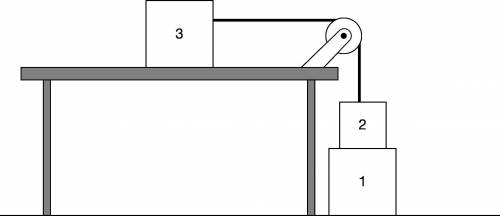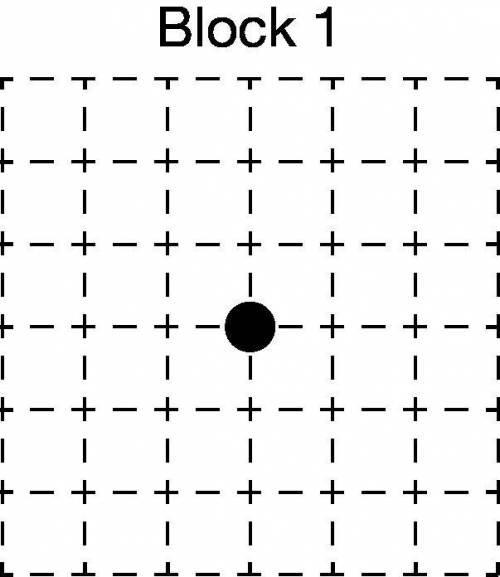
Physics, 27.10.2020 22:50 akeelahbolton4
The figure presents a diagram of three blocks, labeled 1 through 3. In the diagram, block 1 is resting on the floor. Block 2, which is smaller than block 1, is resting on top of block 1. Block 3, which is approximately the same size as block 1, is resting on a table. The right side of block 3 is attached to one end of a string which runs over a pulley located at the right edge of the table. The other end of the string is attached to the top of block 2.
Block 1 is resting on the floor with block 2 at rest on top of it. Block 3, at rest on a smooth table with negligible friction, is attached to block 2 by a string that passes over a pulley, as shown above. The string and pulley have negligible mass.
(a)
i. On the dot that represents block 1, draw and label the forces (not components) exerted on block 1. Each force must be represented by a distinct arrow starting on, and pointing away from, the dot. Draw the relative lengths of all arrows to reflect the relative magnitudes of the forces.
The figure presents a 6 by 6 grid with a dot in the center, labeled “Block 1.”
Question 2
ii. On the dot that represents block 2, draw and label the forces (not components) exerted on block 2. Each force must be represented by a distinct arrow starting on, and pointing away from, the dot. Draw the relative lengths of all arrows to reflect the relative magnitudes of the forces.
The figure presents a 6 by 6 grid with a dot in the center, labeled “Block 2.”
Question 3
(b) Block 1 is removed without disturbing block 2.
i. Consider the scenario where the mass m3 of block 3 is greater than the mass m2 of block 2. Without using equations, make a claim about the motion of block 3 in terms of balanced or unbalanced forces.
Block 3 will move to the right because friction is negligible so Fg would move block 2 down and therefore, tension would pull block 3.
Question 4
ii. Derive an equation for the acceleration of block 3 for any arbitrary values of m3 and m2. Express your answer in terms of m3, m2, and physical constants as appropriate.
Question 5
(c) Describe in what way your answer to part (b)(ii) is or is not consistent with your claim in part (b)(i).
It is consistent with bi because the block3 will be moving to the right.
Question 6
(d) On the axes below, sketch graphs of the velocity and the acceleration of block 2 after block 1 has been removed. Take the time to be zero immediately after block 1 has been removed.





Answers: 3


Another question on Physics


Physics, 22.06.2019 07:50
Calculate the ratio of h+ ions to oh– ions at a ph = 6. find the concentration of h+ ions to oh– ions listed in table b of your student guide. then divide the h+ concentration by the oh– concentration. record this calculated ratio in table a of your student guide. compare your approximated and calculated ratios of h+ ions to oh– ions at a ph = 6. are they the same? why or why not? record your explanation in table a. what is the concentration of h+ ions at a ph = 6? mol/l what is the concentration of oh– ions at a ph = 6? mol/l what is the ratio of h+ ions to oh– ions at a ph = 6? : 1
Answers: 1

Physics, 22.06.2019 10:00
One object has a mass of 1 kg and another object has a mass of 3 kg. if the speeds are the same, which of the following is true about their kinetic energy?
Answers: 2

Physics, 22.06.2019 13:10
The bar of prob. 5/82 is repeated here. the ends of the 0.4-m bar remain in contact with their re- spective support surfaces. end b has a velocity of 0.5 m/s and an acceleration of 0.3 m/s2 in the di- rections shown. determine the angular accelera- tion of the bar and the acceleration of end a.
Answers: 3
You know the right answer?
The figure presents a diagram of three blocks, labeled 1 through 3. In the diagram, block 1 is resti...
Questions

Mathematics, 23.10.2020 14:00

Mathematics, 23.10.2020 14:00


Mathematics, 23.10.2020 14:00

Geography, 23.10.2020 14:00


English, 23.10.2020 14:00

Mathematics, 23.10.2020 14:00

Mathematics, 23.10.2020 14:00

Mathematics, 23.10.2020 14:00



Mathematics, 23.10.2020 14:00



Arts, 23.10.2020 14:00

Mathematics, 23.10.2020 14:00

Health, 23.10.2020 14:00

Mathematics, 23.10.2020 14:00

History, 23.10.2020 14:00



